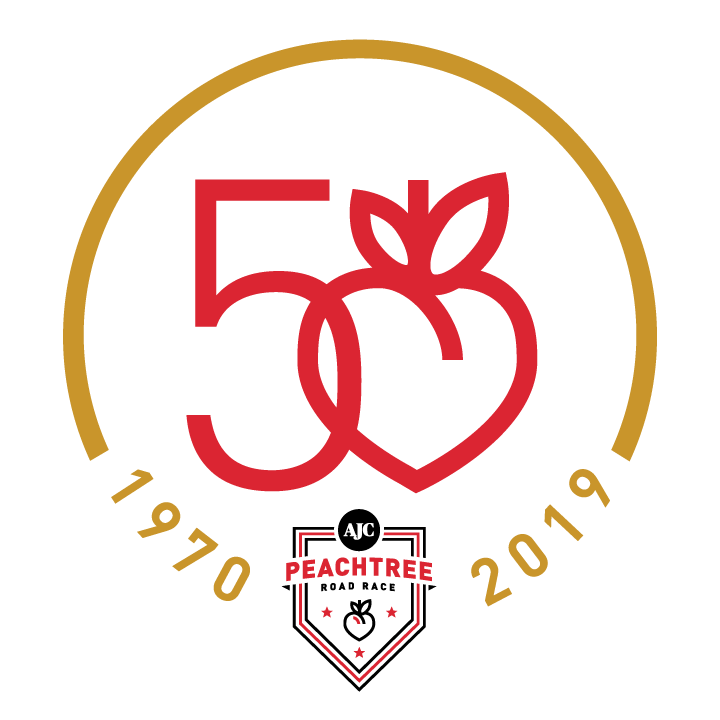Peachtree and the Park

For more than 30 years, Atlanta Track Club and the Piedmont Park Conservancy have been involved in a challenging quest to answer a confounding question: How can tens of thousands of people finish a race within a few hours of each other, get their post-race refreshments, and then enjoy the park but not destroy it at the same time?
The answer has been an evolving formula of preparation, consideration and logistics that is constantly being tweaked. Since 1978 the AJC Peachtree Road Race has finished in (or around) the park, and as the race has grown so have the operations required to manage it.
History of the Peachtree’s Finish
At the beginning, the Peachtree wound its way through the 14th Street gate and finished close to the Piedmont Park bathhouse. Runners would filter around the corner of the lake to chutes parallel to 10th Street and have to make one more ascent to get to the top of Oak Hill for the post-race celebration.
The celebration on Oak Hill
But after 20 years of holding the post-race celebration on top of the hill, the race grew too big. With 55,000 participants in 1998, the Club was forced to transition the post-race gathering into The Meadow, which is still used today. Instead of going up a hill, the runners were now required to navigate down the steep hill leading into the bowl of The Meadow.
That day served as a crucial tipping point in the relationship between the park, the Club and the finish of the Peachtree. Seeing the additional space and relative ease with which the participants fit into The Meadow, it became clear that it was a good solution to the problem of how to contain the ever-growing Peachtree finish. In 1999, then-executive director Julia Emmons moved the finish to 10th Street.
For 20 years, that’s where the finish line has stood – with one notable exception 10 years ago that’s still remembered as one of the most unique Peachtree finishes of all time. Due to drought conditions in 2008, Piedmont Park was unavailable, necessitating a late move onto the streets of Atlanta for the finish.
According to Jack Grosko, the finish area director at the time, “the whole effort was frequently referred to as ‘putting lipstick on a pig,’” as drinks, medical facilities and the T-shirts sprawled down Juniper Street, which served as that year’s finish. Grosko did note that “with a healthy portion of luck and runner goodwill,” they were able to survive with no finish-area backup.
Logistics
Because of the unique relationship between the Peachtree and the park, Atlanta Track Club and the Piedmont Park Conservancy have developed a strong relationship over the decades.
For Piedmont Park Conservancy President & CEO Mark Banta, the most important piece of that logistical operation is making sure they can manage the crowd and ensure that the softscape of the park is not damaged.
“What we want to do in managing dynamic crowd energy is look at anticipating the right amount of room for crowds to move through,” he said, citing a balance of providing enough room to sit while still maintaining space for people to enter the park and move around without overcrowding
The celebration in The Meadow in 2017
Additionally, Banta and the conservancy make sure the grass is cut and properly irrigated just before the race and that the park is looking its greenest and fullest. The biggest concern for the conservancy, of course, is completely out of everyone’s control: the weather.
“The techniques we use are very much dependent on the situation Mother Nature puts us in,” Banta said. For example, if the grounds become muddier, the park offsets that by increasing internal soil percolation rate and using protective flooring.
Perhaps counterintuitively, it’s not rain but rather a serious lack of it that causes the most damage to the roots of the grass when it’s stepped on and increases the aeration challenge afterward (hence making the park off-limits to the race in the drought year of 2008). The muddy year of 2015 was in fact the least damaging to the park, because all of the mud that was created actually worked to churn and aerate the grass.
Essentially, unless conditions are extreme the grass in The Meadow is able to recover quickly even after 60,000 people trample all over it. This is partially due to a sustained effort between the Club and the park to provide flooring in some of the more heavily trafficked areas as reinforcement. For example, that’s why you’ll see flooring on the area for T-shirt collection: Everyone goes there, so that area would otherwise get completely churned up.
Immediately after the race, the park makes a concerted effort to aerate and re-sod any area of The Meadow that suffers damage. As with all of the park’s major events, the work is focused on refreshing the softscape of the park and ensuring that it’s able to recover quickly. Atlanta Track Club covers the costs of these efforts for the Peachtree and the park is able to make a full recovery in just a few weeks.
“Part of what makes this event special is that we make a point to keep the park as safe and as damage-free as possible,” the Club’s Director of Events, Lisa Tanner, said. “The truth is that the more interesting story is in how little damage we do to the park considering that we have 60,000 participants, thanks to the hard work and planning on both sides.”
A little worn down from 60,000 participants, the grass was on its way to recovery soon after this photo was taken.
The Park and the Club
The relationship created by managing the Peachtree has also extended to a commitment from both the Conservancy and Atlanta Track Club to bolster each other’s efforts and create a more-active Atlanta excited to experience the beauty of Piedmont Park.
Over the years, donations from the Club have facilitated the building of both the Active Oval and of the drinking fountains throughout the Park. Each year, the Club also makes a contribution to the Conservancy to further develop active greenspace for Atlantans.
That relationship was honored earlier this year when the Club was recognized with the Legacy Award, for working to make Atlanta a more-active city, at the park’s annual Landmark Lunch.
“It’s a very important relationship for the conservancy,” Banta said. “And we believe it’s an important relationship for the city of Atlanta as a whole. We talk to a lot of people about what events are their most memorable in the park, and the Peachtree Road Race is always in the top one or two.”








